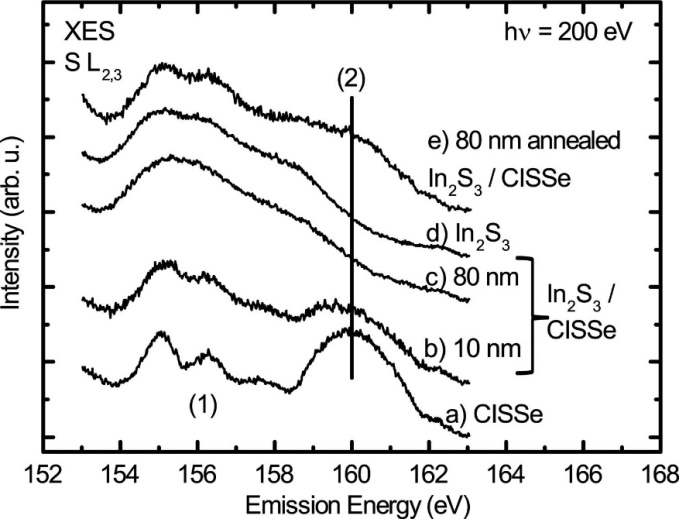EFFCIS
EFFCIS is a BMWi (German Federal Ministry for Economic Affairs and Energy) funded project. The aim of the EFFCIS project is to improve the efficiencies of Cu(In,Ga)(S,Se)2 thin-film solar cells and modules via the improvement of the solar cell’s layers and alternative buffer layers. To achieve this goal, it is of crucial importance to understand and improve the interfaces within the solar cell. Possible ways to improve performance that are investigated in the EFFCIS project, is the use of more transparent buffer layers than CdS (e.g., Zn(O,S) and InxSy) as well as the variation of the Ga/(Ga+In) and the S/(S+Se) ratio in the absorber layer. These changes in turn influence the interfaces within the cell, and it is important gain a detailed knowledge of the resulting changes in chemical and electronic structure.
|
|
 |
| UPS/IPES spectra of a CIGSe absorber and a Zn(O,S)/CIGSe spectra [1] | S L2,3 (hνexc. = 200 eV) XES spectra of a CIGSSe absorber and InxSy/CIGSSe interface structures |
At the IPS and ITCP, the heterojunction of alternative buffer layers with the CIGSSe absorbers are studied by means of a unique combination of soft x-ray and photoelectron spectroscopies. Laboratory-based spectroscopy techniques, namely x-ray photoelectron spectroscopy (XPS), ultraviolet photoelectron spectroscopy, and inverse photoemission spectroscopy (IPES), as well as x-ray-excited Auger electron spectroscopy are utilized. In addition, synchrotron-based soft x-ray spectroscopies (x-ray absorption (XAS), x-ray emission spectroscopy (XES), and resonant inelastic x-ray scattering (RIXS) are used at the synchrotron light sources at KIT and the Advanced Light Source, Lawrence Berkeley National Laboratory, USA.
Project partners
- Zentrum für Sonnenenergie- und Wasserstoffforschung Baden-Württemberg (ZSW)
- Helmholtz-Zentrum Berlin für Materialien und Energie (HZB)
- Martin-Luther Universität Halle-Wittenberg, Institut für Physik
- Technische Universität Darmstadt, Institut für Materialwissenschaft
- KIT-LTI, KIT-LEM
- RWTH Aachen. Physikalisches Institut
- AVANCIS GmbH
- Solibro GmbH
- Mans CIGS Technology GmbH
Contact information: Dr. Dirk Hauschild, dirk hauschild ∂does-not-exist.kit edu
Literature
- [1] M. Mezher, R. Garris, L. Mansfield, K. Horsley, l. Weinhardt, D. Duncan, M. Blum, S. Rosenberg, M. Bär, K. Ramanathan, and C. Heske, Prog. Photovolt: Res. Appl. 24, 1142–1148 (2016)
- [2] D. Hauschild, F. Meyer, A. Benkert, D. Kreikemeyer-Lorenzo, S. Pohlner, J. Palm, M. Blum, W. Yang, R. G. Wilks, M. Bär, C. Heske, L. Weinhardt, and F. Reinert, J. Phys. Chem. C 119, 10412-10416 (2015).

